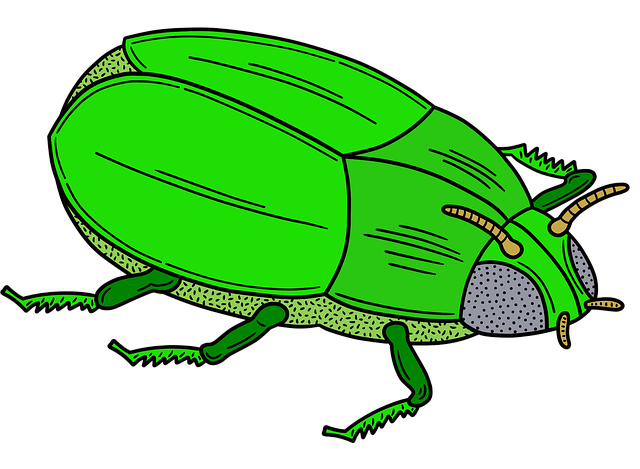Beetles exhibit distinct seasonal behaviors, with increased activity during warmer months due to optimal food and breeding conditions. Spring and summer see a rise in populations as adults emerge, mate, and feed, while fall presents a mix of species seeking shelter or continuing to feed. Effective beetle control solutions require understanding these shifts, implementing strategic plans tailored to local species' life cycles. This includes multi-faceted tactics like biological controls, seasonal pesticides, debris removal, and structural repairs. Seasonal adaptability is key: spring focuses on deterrents and cleaning, summer on protective barriers, autumn on deep cleaning, and winter on warmth management. Regular monitoring and adjustments ensure a robust, year-round protection plan.
“In the never-ending battle against beetles, a strategic, year-round approach is key to maintaining a pest-free environment. This comprehensive guide explores seasonal prevention programs, offering insights into understanding beetle behavior and implementing effective control solutions tailored for each season.
From identifying peak activity periods to adopting proactive strategies, you’ll discover how to develop a robust defense. We delve into specific control measures, providing practical tips for successful long-term management. Embrace a holistic approach to beetle control solutions and reclaim your space from these intruders.”
Understanding Seasonal Beetle Behavior: When and Why They Strike
Beetles, with their diverse habits and life cycles, exhibit distinct seasonal behaviors that can help predict their activity levels throughout the year. Understanding when and why they strike is crucial for implementing effective beetle control solutions. In general, beetles are more active during warmer months when food sources are abundant and environmental conditions are favorable for breeding.
Spring and summer often see an increase in beetle populations as adults emerge from pupae and begin mating, laying eggs, and feeding aggressively. Fall brings a different dynamic, with some species seeking shelter for the winter while others continue to feed and prepare for the coming cold. Knowing these seasonal shifts allows property owners and pest management professionals to proactively develop and implement targeted beetle control strategies, ensuring year-round protection.
Proactive Approach: Developing a Year-Round Prevention Strategy
Beetle control is best approached with a proactive strategy, aiming for year-round prevention rather than reactive treatment. Developing a comprehensive, multi-faceted plan ensures effective beetle control solutions tailored to local species and their life cycles. By understanding the specific behaviors and habitats of target beetles, professionals can implement targeted tactics throughout the seasons.
This might include a combination of biological controls like introducing natural predators, seasonal applications of targeted pesticides, regular debris removal to minimize hiding spots, and structural repairs to prevent access. A proactive approach not only minimizes beetle populations but also reduces the risk of damaging infestations that require more intensive and costly treatments later in the year.
Effective Beetle Control Solutions for Different Seasons
Effective beetle control solutions vary with each season, requiring tailored strategies for optimal results. In spring, when beetles emerge from hibernation, preventive measures focus on sealing entry points and maintaining a clean environment to deter them from settling. Regular inspections and prompt treatment of any early signs of infestation are crucial during this period.
Summer calls for proactive approaches, such as implementing protective barriers and utilizing natural repellents. Landscapers and homeowners can also benefit from regular tree and shrub maintenance to reduce beetle habitat. Autumn offers an opportunity for deep cleaning and sanitizing, eliminating potential winter hiding spots. Finally, in winter, maintaining warmth inside structures and addressing any existing infestations promptly helps ensure year-round beetle control.
Implementing and Monitoring: Tips for Successful Long-Term Management
Implementing and monitoring seasonal prevention programs is key to achieving successful, long-term beetle control. Begin by assessing your property’s vulnerability during each season, focusing on potential entry points and breeding grounds. This involves regularly inspecting exterior areas for signs of damage or infestation. Once identified, implement targeted strategies such as sealing gaps with weatherproof materials, removing debris that serves as hiding places, and treating affected zones with eco-friendly insecticides. Regular monitoring includes setting up traps in strategic locations and conducting thorough inspections after significant weather events. By staying vigilant and adapting your beetle control solutions according to seasonal changes, you can maintain a year-round protection plan that keeps these pests at bay effectively.
Seasonal prevention programs offer an effective strategy for year-round beetle control, addressing specific behaviors and needs at every stage. By understanding when and why beetles strike, professionals can implement a proactive approach that combines targeted interventions with sustainable practices. Through seasonal adjustments to beetle control solutions, from spring grooming to winter maintenance, property managers can ensure long-term protection. Implementing these strategies, coupled with regular monitoring, allows for swift responses to changing patterns, making it possible to maintain a pest-free environment throughout the year.
